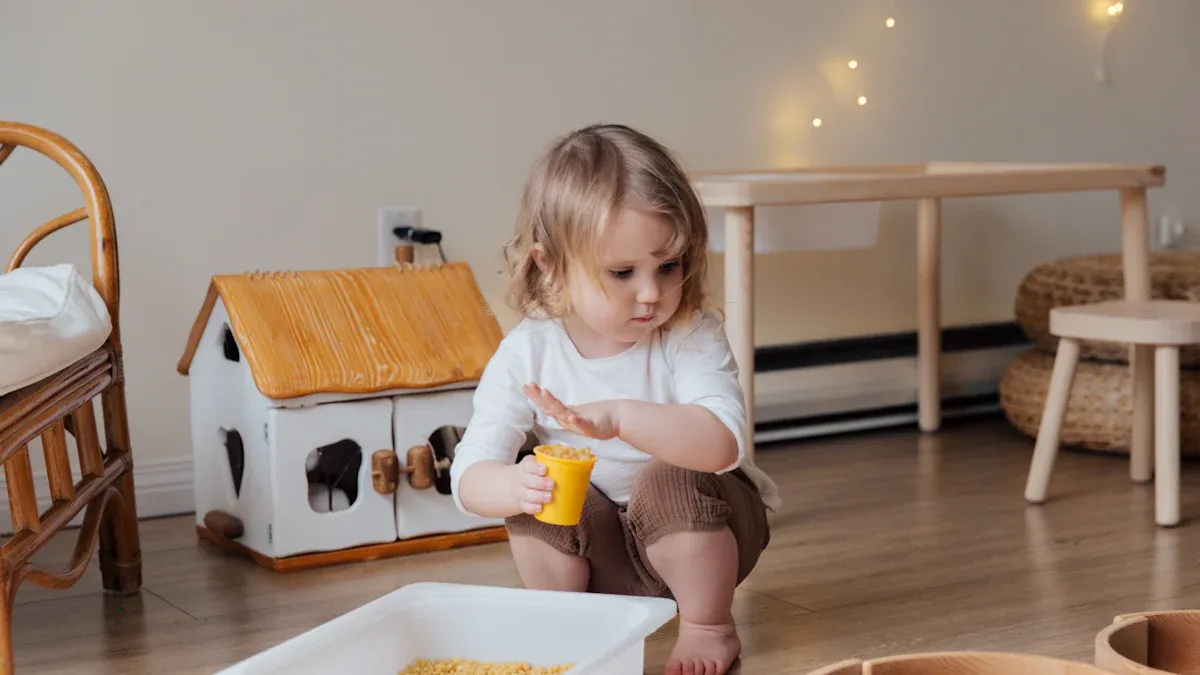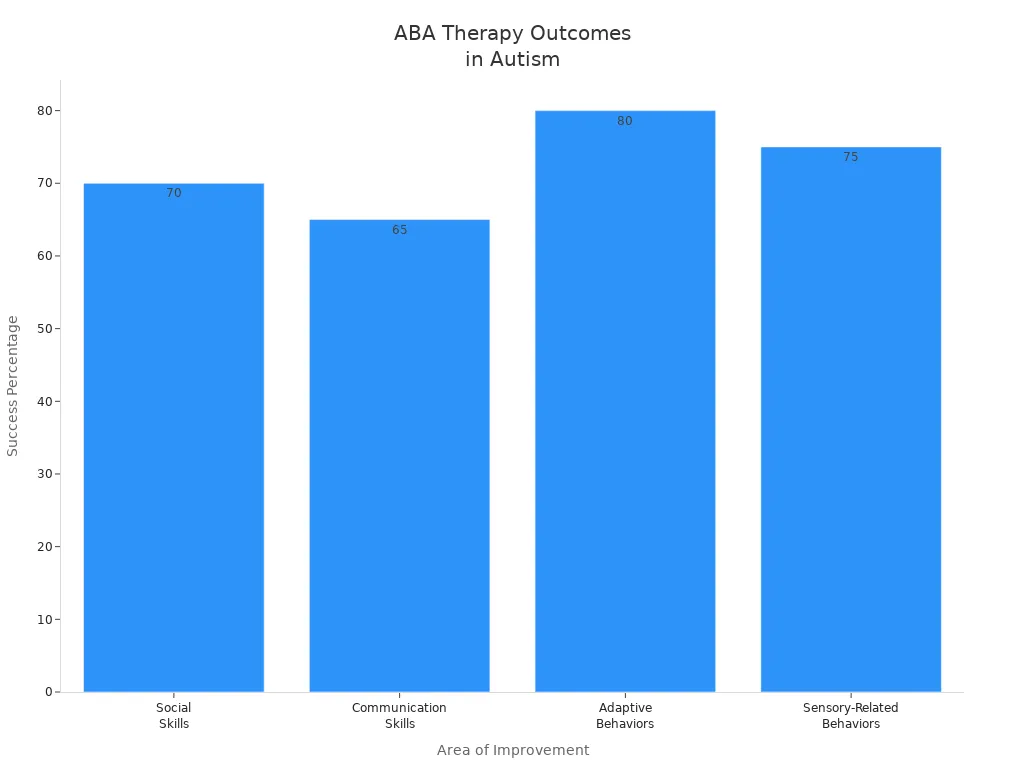Therapies for Autism Sensory Issues

You might see that autism sensory issues are very common. Almost 95% of kids with autism have trouble with sensory processing. This can mean they are too sensitive or not sensitive enough to things like sound, touch, or light. These problems can make daily life hard for you, your child, or your students.
Sensory Integration Therapy helps kids with autism get used to different sensory inputs.
ABA therapy uses both sensory and behavior methods.
Many families and teachers worry about how sensory issues affect learning and daily life, but using headphones, fidgets, and changing the environment can really help.
Key Takeaways
Almost 95% of kids with autism have trouble with sensory processing. Finding these problems early helps kids get better support and therapy.
Sensory Integration Therapy helps kids get used to different sensory inputs. It uses play and planned activities. This helps kids do better in daily life.
ABA Therapy looks at behaviors linked to sensory issues. It uses rewards and plans to teach new skills. It also helps kids handle sensory overload.
Making sensory-friendly spaces at home or school can lower stress. It helps kids focus more. This makes daily routines easier.
Adding sensory activities to daily life helps kids feel better. Things like movement breaks and tactile play help kids stay comfortable and interested.
Autism Sensory Issues

Common Signs
Autism sensory issues can look different for each child. Some kids cover their ears when sounds are loud. Others do not like certain foods because of taste or texture. You might see a child flap their hands or rock back and forth. These actions help them feel better when things are too much.
Here’s a quick look at the most common sensory processing challenges in autism:
Sensory Processing Challenge | Description | Impact on ASD Symptoms |
|---|---|---|
Hypersensitivity | Very strong reaction to things like noise or touch | Makes it harder to talk or play with others |
Hyposensitivity | Not noticing things like pain or sound | Can lead to doing the same action over and over |
Sensory seeking behaviors | Wanting to feel or do certain things a lot | Changes how a child acts and plays with others |
Some kids are bothered by bright lights or loud sounds. Others want to spin or touch soft things often. Some do not notice pain or if something is hot or cold. These signs can make daily life hard for you and your child.
When to Seek Help
You might wonder when to ask for help with sensory issues. If these problems make it hard for your child to go to school, play, or do daily things, it is time to get support. Sensory processing disorder can change how your child learns and feels about themselves.
Tip: If your child gets upset by sounds, lights, or touch, and this stops them from having fun, talk to a doctor or therapist who knows about autism.
Here are some ways autism sensory issues can impact daily life:
Loud sounds or bright lights can upset your child and make them want to be alone.
These problems can make school, friends, and routines harder.
Busy places like classrooms can make sensitivities worse.
Many families see that sensory issues are missed, even though they are a big part of autism.
You do not have to face these problems by yourself. Support and therapy can help your child feel better and more sure of themselves every day.
Therapies Overview
When you want help with autism sensory issues, you will find a few main therapies. Each therapy has its own focus. All of them try to make life easier for you and your child. Let’s look at the most common choices. This way, you can see what might help.
Sensory Integration Therapy
Sensory integration therapy is a popular choice for kids with autism. You may hear about it if your child has trouble with loud sounds, bright lights, or certain textures. In this therapy, a trained therapist uses play and planned activities. These help your child get used to different sensory inputs. The therapist may use brushes, swings, or squeeze toys. These tools help your child feel safe while trying new things.
Studies show that sensory integration therapy can help a lot. Kids often have better balance and stronger motor skills after a few sessions. They also feel more comfortable in daily routines. Here is a quick look at what research found:
Study Focus | Findings |
|---|---|
Overall effectiveness of sensory integration therapy | Significant improvements in quality of life and sensory processing for children with ASD. |
Motor skills improvement | Enhanced motor ability and balance skills after a 12-session intervention. |
Occupational performance | Notable improvements in all assessed domains in the intervention group compared to control. |
Communication and socialization | Significant enhancements in communication, socialization, and daily living skills post-intervention. |
You may see your child feel calmer and more ready to join in at home or school. Many families say their child feels more confident and less stressed by daily things.
ABA Therapy
ABA therapy is another well-known way to help with autism. This therapy looks at why certain behaviors happen, especially those linked to sensory issues. Therapists use rewards, social stories, and small steps to teach new skills. They also help your child handle tough moments.
ABA therapy often starts with a Functional Behavior Assessment. This helps the therapist learn what causes your child’s sensory problems. Then, they make a plan just for your child. You may see your child practice staying calm during loud sounds. They may also learn to ask for a break when things get too hard.
ABA therapy has strong research support. Many kids improve their social skills, talking, and how they handle sensory overload. Look at this chart to see how ABA therapy helps in different areas:

Therapists also use sensory breaks, special materials, and changes to the room. These ideas help lower stress and make it easier for your child to join in.
Occupational Therapy
Occupational therapy is another important part of sensory-based therapies for autism. An occupational therapist helps your child with daily skills. These can be getting dressed, eating, or playing with friends. They use sensory integration therapy and also work on motor skills and being independent.
You may see your child use swings, foam mats, or special tools in therapy. The therapist makes a sensory diet. This is a set of activities that help your child feel calm and focused. These activities can happen at home, school, or in the therapy room.
Here is how occupational therapy helps:
Therapists make sensory diets that fit your child’s needs.
They teach you and your child how to handle sensory overload.
They use play and movement to build confidence and comfort.
Parents and teachers learn how to use these ideas every day.
Occupational therapy is supported by health experts. It helps kids with autism feel more in control and ready for new things.
Therapy | Intervention Techniques | Main Outcomes | Evidence Base |
|---|---|---|---|
Occupational Therapy | Sensory integration, motor exercises, environmental modifications, play-based activities | Improved sensory processing, motor skills, independence in daily routines | Strong clinical evidence, endorsed by health authorities |
ABA Therapy | Reinforcement, discrete trial training, social stories, functional behavior assessments | Reduced problematic behaviors, improved communication and social skills | Extensive research validation, endorsed by U.S. Surgeon General |
Sensory Activities
You can also use sensory activities at home or in class to help your child. These activities are simple, fun, and easy to add to your day. Sensory activities can be playing with textured balls, walking on a sensory path, or taking movement breaks during homework.
Here are some ideas you can try:
Sensory walls and walks: Let your child touch different textures or walk barefoot on soft mats.
Movement breaks: Give your child time to jump, stretch, or dance between tasks.
Create a sensory-friendly space: Use soft lighting, quiet corners, or noise-canceling headphones to help your child feel safe.
These activities help your child stay calm, lower stress, and keep learning. You may notice your child feels happier and more focused after a few minutes of sensory play.
Tip: Try adding sensory activities to your child’s daily schedule. Even small changes can help your child feel and act better.
How Sensory Integration Therapy Works

Therapy Goals
When you begin sensory integration therapy, you want to see changes. The main goal is to help your child react better to sounds and touches. Movement is also important in this therapy. After a few sessions, your child may feel calmer. Your child might also feel more confident. Therapists use play-based activities with touch, movement, sound, and vision. These activities help your child’s brain learn new ways to handle sensory input. The therapy uses a “just right” challenge. This means activities are not too easy or too hard. This keeps your child interested. It helps your child build new skills. Over time, sensory integration therapy can improve motor abilities. It can also help thinking skills and social interactions.
Note: Sensory integration therapy uses the brain’s ability to change and grow, called neuroplasticity. This helps your child learn new ways to process sensory information.
Techniques Used
Therapists use many fun and structured activities in sensory integration therapy. These activities help your child explore different sensations safely. Here are some common techniques:
Jumping on trampolines helps build balance and coordination.
Playing with sensory bins filled with rice, sand, or water beads helps with touch.
Messy play like finger painting or making slime helps your child enjoy new textures.
Water play with different temperatures and containers helps motor skills.
Swinging or climbing helps with movement and regulation.
Activity Type | Examples | Benefits | Extra Tips |
|---|---|---|---|
Sensory Exploration | Sand/water bins, natural items | Calming, tactile processing | Try household objects |
Motor Regulation | Trampolines, swings, climbing | Balance, coordination | Always supervise |
Creative Expression | Painting, scented playdough | Self-expression, engagement | Adapt for sensitivities |
These activities make sensory integration therapy fun and helpful for children with autism.
Customization
Every child with autism is different. Sensory integration therapy must fit your child’s needs. Therapists start with an assessment to learn about your child’s sensory sensitivities. They make a plan using deep pressure activities and play-based therapy. Other techniques match your child’s sensory profile. Your child may use squeeze toys, brushes, or swings. Therapists change the plan as your child grows and changes. This personal approach helps your child get the most from therapy. It helps your child feel more comfortable in daily life.
Tip: Ask your therapist how you can use some of these activities at home. Small changes can make a big difference for your child with autism.
Practical Strategies at Home and School
Sensory-Friendly Spaces
You can help kids with autism by making sensory-friendly spaces. These places help lower stress. They also help your child focus better. Use soft and natural lighting. Incandescent bulbs are better than bright fluorescent lights. Try to keep loud noises away. Quiet rooms give your child a safe spot when things get too much.
Put bean bags or rocking chairs in the room for comfort.
Keep rooms neat and do not let clutter pile up.
Hang a daily schedule where your child can see it.
Use calming scents with essential oils or a diffuser.
Tip: Sensory-friendly spaces help stop sensory overload. They also help kids feel comfortable, focus, and be more independent.
Sensory Diets
A sensory diet is a group of activities for kids with autism. These activities give the sensory input your child needs. An occupational therapist can help you make a plan. Every child with autism has different sensory needs. A good sensory diet matches what your child needs.
Add activities like jumping, swinging, or squeezing stress balls.
Plan movement breaks during the day.
Use visual schedules to show when sensory activities happen.
Watch your child’s reaction and change the plan if needed.
A sensory diet helps your child stay calm and pay attention. It also helps your child join in at home and school.
Behavioral Strategies
You can use easy behavioral strategies to help with sensory problems. Keep routines the same each day. Give choices when you can. Use visual supports or timers to help your child get ready for changes. This lowers anxiety and helps your child feel confident.
Use positive rewards to help your child try new sensory things.
Give sensory breaks with calming activities like soft music or rocking.
Give clear and simple instructions. Allow extra time to answer.
Make safe and quiet spaces for your child to use when they feel stressed.
Note: These strategies help kids with autism feel more in control. They also help kids get ready for daily life.
Benefits of Therapy
Daily Functioning
Therapies for autism can help make daily life easier. Sensory-based therapies help your child handle sounds, sights, and touches. You may see your child get dressed with less help. Your child might focus longer on homework. These changes can make mornings and nights less stressful.
Here’s how therapy can help with daily life:
Improvement Type | Description |
|---|---|
Your child learns to handle sensory input more easily. | |
Social Functioning | You see better eye contact and smoother social interactions. |
Adaptive Functioning | Your child becomes more independent with self-care tasks. |
Attention | Focus and engagement in activities improve. |
Self-Regulation Skills | Your child finds ways to manage sensory needs and join daily routines. |
You may see your child brush teeth or put on shoes alone. These small steps help your child feel proud.
Tip: Sensory interventions help your child stay calm and focused. This makes daily routines easier for everyone.
Emotional Regulation
It can be hard for kids with autism to manage feelings. Therapy gives your child ways to handle strong emotions. You may hear about cognitive behavioral therapy or mindfulness programs. These teach your child to notice feelings and use calming strategies.
Cognitive behavioral therapy helps your child change negative thoughts and handle stress.
Mindfulness activities, like deep breathing, help your child relax and feel more in control.
Programs such as EASE and Secret Agent Society use games and stories to teach emotion awareness.
You may see fewer meltdowns or faster recovery after tough times. Your child learns to talk about feelings and use coping skills.
Note: Knowing your child’s sensory patterns can help you find the right emotional support.
Participation
Therapy helps your child join in at school and with friends. You may see your child play more with classmates or join group activities. Social skills groups help kids with autism practice talking, sharing, and working together.
Group social skills programs build confidence and social abilities.
Kids feel better about their social skills after therapy.
Task-based activities help your child learn new skills and use them in real life.
Your child might raise their hand in class or join a game at recess. These moments help your child feel included and make friends.
Tip: When your child joins in more, you see growth in learning, social life, and independence.
Finding Professional Support
Where to Start
It can be hard to know where to start when you want help for autism sensory issues. Begin by watching your child closely every day. Notice what things bother them, like loud sounds or scratchy clothes. Talk with your child about what makes them feel upset or calm. When you talk openly, you learn what your child needs.
Here is an easy plan you can follow:
Watch for things that upset your child early. Look for signs like fidgeting or worry.
Ask your child to tell you how they feel about sounds, lights, or touches.
Make a quiet spot at home. Calm rooms and relaxing activities help your child feel safe.
Meet with an occupational therapist. They can help you make a plan for your child’s sensory needs.
Try a sensory diet. Add activities that help balance how your child feels and help with emotions.
If your child has trouble with daily tasks or being with others, ask a professional for help. You do not have to do this all by yourself.
Questions to Ask
When you meet a therapist, you want to know they can help. Ask about their training and experience. Look for someone who is a Certified Autism Specialist (CAS). This means they know how to help with behavior and sensory needs.
Here are some questions you can ask:
Have you learned special ways to help with sensory processing?
Is there a BCBA who checks my child’s case? How often do they watch sessions?
How do you find out what upsets my child’s senses?
What do you do to help my child get used to new things or take breaks?
Who is on the team that helps my child?
A good therapist will answer your questions in a way you understand. They will help you feel sure about your child’s care.
School and Community Resources
You can find many places that help with autism sensory issues near you. Schools may have classrooms and teams that help with sensory needs. Community groups offer classes, events, and safe places for families.
Here is a table with some helpful places and programs:
Resource Name | What They Offer |
|---|---|
UW Autism Center | Workshops, summer camps, and training sessions |
Different Brains | Educational resources and personal stories |
Outside the Box Sensory | Free downloads and online support |
See Me | Community events for neurodiverse families |
Hands on Children's Museum | Sensory Friendly Hours for children |
Sensory Tool House, LLC | Recreational resources for special needs |
Neurodiversity Network | Education and employment resources |
Sensory Room at Seattle-Tacoma Airport | Calm space for travelers with sensory needs |
Pacific Science Center | Special hours for autism families |
Lumen Field & Climate Pledge Arena | Sensory rooms and sensory bags during events |
Woodland Park Zoo | Sensory tools and quiet areas |
Sensory-Friendly Shows | Performances with sensory accommodations |
Tip: Ask local groups about programs for kids with sensory needs. You can find help and new ideas to support your child with autism.
You can help a lot by noticing sensory issues early. Therapies like ABA and occupational therapy help kids learn new skills. These therapies also help kids feel better each day. Making sensory-friendly spaces helps your child feel calm. Using calming tools can lower your child’s anxiety. This helps your child join more activities.
Getting help early and working with your family helps your child do better.
Local services and support groups let you meet experts and other families.
If you ask for help and use simple tips, your child can do their best. You are not alone—there is always support for you. 😊
FAQ
What is the best therapy for autism sensory issues?
You might find that no single therapy works for every child. Many families see good results with sensory integration therapy or occupational therapy. Try different options and see what helps your child feel calm and happy.
Can I do sensory activities at home?
Yes! You can set up simple activities like playing with textured toys, using a swing, or making a quiet corner. These small changes can help your child feel more comfortable every day.
How long does it take to see progress?
Every child is different. Some kids show changes in a few weeks. Others need more time. Stay patient and keep working with your therapist. Celebrate small wins along the way!
Will my child always have sensory issues?
Many kids learn ways to manage their sensory needs as they grow. Therapy and support help a lot. Your child may always notice things differently, but you can help them feel more confident and comfortable.
See Also
Exploring Support Strategies For Autism Sensory Overload
Sensory Playthings That Bring Calm To Autistic Children
Creating A Sensory Gym Space For Kids With Autism
